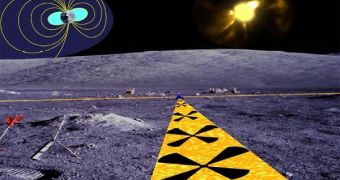NASA finally seems interested in a scientific proposition that was mainly laughed at in the past: a radio observatory on the Moon. The idea is not new, earlier this year an American astronomer proposing that we build a giant liquid-mirror telescope on the Moon, saying that it will be hundreds of times more accurate and sensitive than even the Hubble Space Telescope.
The agency asked the US National Research Council (NRC) in 2006 to advise it on what kinds of science could be tackled from the Moon and what projects should be given top priority. This week, an NRC committee presented a report on the subject.
It seems that the idea of actually building a radio observatory on the far side of the Moon is considered most promising by the committee. The project will come in the form of metallic antennas plated onto a flexible plastic film that can be rolled up for transport to the Moon, then unrolled on the lunar surface like a carpet, creating an instant array of radio receivers.
This would be a very useful instrument, able to investigate very low frequency sources in the 1 to 10 megahertz range, which would normally be drowned out by the constant din of radio traffic from Earth.
"The far side of the Moon is one of the most radio quiet places in the solar system, because it's the one place that doesn't really have any time in view of the Earth", says David Lawrence of the Los Alamos National Laboratory in New Mexico, US, a member of the NRC committee that prepared the report.
Using the advantages offered by the far side of the Moon, the observatory could map out structures from the "dark age" of the early Universe and could even search for planets orbiting other stars, just by "hearing" them, including their internal structure and composition.

 14 DAY TRIAL //
14 DAY TRIAL //